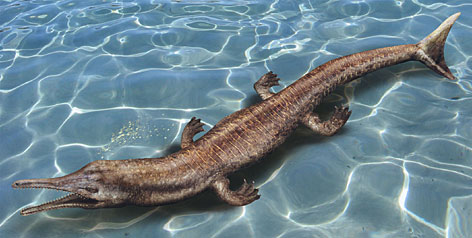
July 9, 2007
I posted the news of this fossil find of a prehistoric crocodile here on Cryptomundo in April.
See Sea Monster Found in Oregon.

Cryptomundo reader mjmurphy tipped me off to an article concerning this find that likened the fossil find to descriptions of a Native American water monster and the research of Adrienne Mayor, an independent scholar of natural history folklore and the early history of science and author of Fossil Legends of the First Americans.
Click on bookcover image to purchase the book at Amazon.com.
Crocodile fossil hunt is big fish story
A walk into the high desert of Oregon has netted an amateur paleontologist a heck of a fish story, and perhaps some unexpected insight into a Native American totem animal.
“That morning, what I saw was a skull weathered out of a hillside,” says Andrew Bland of the North American Research Group (NARG), a hobbyists’ group looking for fossils last year on a rancher’s land in eastern Oregon’s Crook County. “I followed it up the hillside and saw there was a lot of it. Then I got excited.”
Digging into the hillside over a day and a half, the team uncovered almost half of a six to eight-foot long crocodile, Thalattosuchia, which lived more than 160 million years ago during the Jurassic era. Remarkably, the croc had a fish tail (although its exact shape remains in contention), which along with the needle teeth found in the skull must have made it swift predator at sea. The creature most likely made its living in what is today the South China Sea, and continental drift carried the rock encasing the fossil to Oregon tens of millions of years ago, according to University of Oregon geologist, William Orr.
Anyone who thinks fossil collecting is easy should bear in mind that Bland spent the next six months air-blasting rock away from the fossil to reveal all its jumbled pieces. The team hopes to show the “Crook County croc” at the Rice Northwest Museum of Rocks and Minerals in Hillsboro, Ore., where NARG regularly meets, after a two-year study of the fossil remains at the University of Iowa. “Interesting that in a desert environment you can find marine fossils, but there it was,” Bland says.
Most intriguing, the initial restoration of the fossil croc bears a striking resemblance to a mythic animal of some Native American tribes, the Kiowa, Sioux, Pomo of northern California and others, says Adrienne Mayor, a visiting scholar at Stanford University, author of Fossil Legends of the First Americans. A University of Oregon artist’s depiction of the crocodile greatly resembles the Kiowa artist Silverhorn’s 1891-94 sketch of a water monster with scales, a long narrow head with needle teeth and a forked fish-tail drawn to illustrate water serpent legends, Mayor says. The Pomo Indians described a fish-tailed, needle-toothed water monster called Bagil, as well.
A sketch by the famous Kiowa artist Silverhorn, from about 1891-1894, of the Kiowa water monster.
National Anthropological Archives,
Smithsonian“Obviously, Native Americans who found remarkable fossils didn’t just ignore them,” Mayor says. “Naturally they speculated about (fossils.) They organized special trips to fossil sites and tried to imagine how the creatures lived and died. Their fossil stories were not formal science, but they contained insights based on keen observation of evidence. Some of their ideas, even though they were expressed in myths, anticipated modern scientific theories about extinction.”
Mayor occupies a fascinating niche in paleontology, examining links between fossils and ancient myths. In previous work she examined how fossil finds in ancient Greece may have contributed to the notion of Zeus slaying ancient Titans with lightning bolts.
“I do believe that Adrienne Mayor is on to something here,” says of California State Parks archaeologist E. Breck Parkman, by e-mail. “As she has noted in her earlier work, there is a good possibility that earlier people observed the fossils of odd and extinct creatures and then went on to interpret those creatures in their mythologies. An example is found in North Asia, where Native peoples of Siberia apparently observed the remains of mammoths eroding from the ground and then created stories of great underground creatures that lived during mythological times.”
A very similar dragon-creature is described from northeastern California, Parkman adds. The Ajumawi people have a legend of a big serpent-like creature with fish tail and elk antlers, similar to Bagil.
“Antlers or horns are common in Native American depictions of sacred or mysterious creatures,” Mayor notes.
Parkman also notes at Serpent Cave, in Baja California, “there are beautiful cave paintings of big serpent-like figures sporting deer antlers and fish tails. In British Columbia, in the Stein River Valley, there are rock paintings of alligator-like creatures sporting fish tails. Rock art depictions of alligator-like creatures also occur elsewhere in the U.S., including Utah, Arizona, and Ohio.”
One skeptic about a mythology connection, however, is Bland, who well remembers how much work it took to unearth his find. “It’s always possible, but it’s hard to imagine someone finding something complete enough to get a good idea of appearance just walking by.” Marine fossils that travel by plate tectonic thousands of miles in particular often arrive jumbled, he says, and typically take a lot of work to expose. “Just looking for fossils is a voyage of discovery every time we go out there. You have to be aware something like this may be out there. And you have to get lucky.”Dan Vergano, USA TODAY
About Craig Woolheater
Co-founder of Cryptomundo in 2005.
I have appeared in or contributed to the following TV programs, documentaries and films:
OLN's Mysterious Encounters: "Caddo Critter", Southern Fried Bigfoot, Travel Channel's Weird Travels: "Bigfoot", History Channel's MonsterQuest: "Swamp Stalker", The Wild Man of the Navidad, Destination America's Monsters and Mysteries in America: Texas Terror - Lake Worth Monster, Animal Planet's Finding Bigfoot: Return to Boggy Creek and Beast of the Bayou.
Filed under Artifacts, Bigfoot Report, Cryptozoology, Evidence, Folklore, Fossil Finds, Lake Monsters, Photos, Sea Serpents